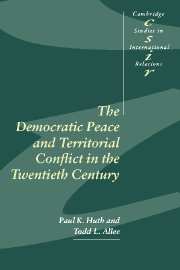Book contents
- Frontmatter
- Contents
- List of figures
- List of tables
- Acknowledgments
- 1 Another study of democracy and international conflict?
- 2 Pathways to conflict escalation and resolution in international disputes
- 3 The international strategic context
- 4 Domestic institutions and the Political Accountability Model
- 5 Domestic institutions and the Political Norms Model
- 6 Domestic institutions and the Political Affinity Model
- 7 Empirical results for decisions to challenge the status quo
- 8 Empirical results for decisions to offer concessions in negotiations
- 9 Empirical results for decisions to escalate with military force
- 10 What have we learned about the democratic peace?
- Appendices A–F
- Bibliography
- Index
- CAMBRIDGE STUDIES IN INTERNATIONAL RELATIONS
6 - Domestic institutions and the Political Affinity Model
Published online by Cambridge University Press: 22 September 2009
- Frontmatter
- Contents
- List of figures
- List of tables
- Acknowledgments
- 1 Another study of democracy and international conflict?
- 2 Pathways to conflict escalation and resolution in international disputes
- 3 The international strategic context
- 4 Domestic institutions and the Political Accountability Model
- 5 Domestic institutions and the Political Norms Model
- 6 Domestic institutions and the Political Affinity Model
- 7 Empirical results for decisions to challenge the status quo
- 8 Empirical results for decisions to offer concessions in negotiations
- 9 Empirical results for decisions to escalate with military force
- 10 What have we learned about the democratic peace?
- Appendices A–F
- Bibliography
- Index
- CAMBRIDGE STUDIES IN INTERNATIONAL RELATIONS
Summary
In this chapter we present the Political Affinity Model, our final theoretical approach for understanding how domestic political institutions can influence the foreign policy choices of state leaders. The theoretical insight offered by this model is that international bargaining over disputed territory should be examined within the broader context of the bilateral political relationship between challenger and target. Instead of elite norms or levels of political accountability playing a central explanatory role, in this model leader perceptions of shared political ties are of primary theoretical importance.
Political Affinity Model
The theoretical analysis centers on how domestic institutions shape decision-makers' assessments of whether other state leaders have common or divergent interests on fundamental issues of domestic and international security. Figure 6.1 presents the principal causal links in the model. The logical foundation is that common political institutions and ideologies between states produce shared political interests among those states' incumbent elites regarding whether preservation or change in the political status quo is desirable. Our argument is that leaders whose states share common political institutions and ideologies are less likely to adopt foreign policies that put each other's international and domestic security at risk. As a result, politically similar states should view each other as potential allies, while dissimilar states are likely to perceive one another as potential security threats. Incumbent leaders thus have stronger incentives to adopt more cooperative foreign policies towards political allies.
- Type
- Chapter
- Information
- Publisher: Cambridge University PressPrint publication year: 2003

